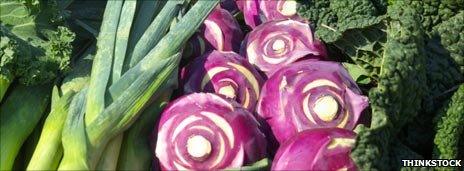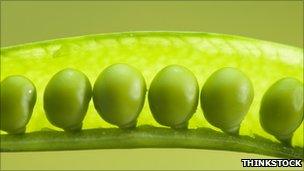What is the UK's national vegetable?
- Published

British TV chefs and restaurateurs are keen for us to eat locally grown produce. But is there a single national vegetable?
Leeks are Welsh. Potatoes are associated with Ireland. And overcooked cabbage, cauliflower and sprouts are classic school dinner fare.
Asparagus is a strong contender for an English vegetable, coming into season on St George's Day, says Nora Ryan, editor of the BBC Food website. But is there one that could be described as Britain's national vegetable?
"The French have the green bean, garlic and onions, Eastern Europeans have the beetroot and cabbage, and Italians can lay claim to the tomato," she says.
BBC Two's new series The Great British Food Revival seeks to revive interest in traditional crops under pressure from exotic rivals, market pressures and changing food fashions.
Food historian Ivan Day says it is hard to narrow down a quintessential vegetable as British cookery has, historically, lavished more attention on meat and fish dishes. And many contenders have their origins in other countries. Kale and leeks date from before the Norman conquest, but the cool climate has long limited choices for gardeners.
What about the humble spud - where would these islands be without mash, chips and potato-laden Irish stew?
This vegetable comes from foreign climes. The first eaten here were sweet potatoes, used in desserts in the late 16th Century, says Day. But, as natives of Spanish colonies in central America, these didn't grow well in Britain.
White potatoes from North America, however, flourished. "They nudged themselves in gradually. It wasn't until the late 18th Century that potatoes became a staple, replacing bread or pie crust. They were particularly popular in the 'oat counties' - northern England and Scotland - where wheat didn't grow easily. Potatoes were a welcome substitute for coarse oat cakes."

The garden pea: Ivan Day's nomination
Our attitudes to vegetables are not static, says Day. "In the past 40 years, we've been introduced to more vigorous tasting vegetables, from aubergines and peppers to salad leaves from the Far East. Bigger flavours have outshone our traditional vegetables."
Cauliflower sales alone have fallen by 35% in the past decade, supplanted largely by its greener cousin broccoli, which has been cannily marketed as a superfood, says Philip Lowery, of the Real Food Festival.
"Because of this idea that green and colourful vegetables are more nutritious, the poor, pale cauliflower has suffered in comparison. But it's full of folic acid and vitamin B6."
Sales of traditional veg rallied somewhat five years ago thanks to the vogue for locally sourced ingredients and classic British dishes.
But today, sales have fallen again - Brussels sprouts down 5.8% and cauliflowers down 2.9% in the past year, according to Kantar Worldpanel figures - and only four in 10 households still eat caulis.
Tellingly, those keen to reawaken our love of caulis, cabbage and sprouts typically lace their recipes with strong-tasting ingredients such as chilli, garlic, bacon or stinky cheeses (not all in the same dish).
Cooks in India used similar tactics when colonial Britons introduced the cauliflower to the sub-continent. Revved up with cumin, ginger and mustard seeds, aloo gobi - cauliflower and potato curry - was born.
Day's own pick for a national vegetable? The garden pea.
It grows easily throughout Britain, and has done for centuries. Its name dates from Chaucer's time, when it was known as pease. In its dried form, the pea is the basis for traditional staples such as pease porridge. When eaten fresh, with little more than butter as a garnish, it was prized by Tudor kings and commoners alike as a welcome burst of bright green in summer.
"And then there was the miracle of frozen peas in the 1950s," says Day.
Proud Scots might nominate neeps and tatties - mashed swedes (or turnips) and potatoes - that are the traditional accompaniment to haggis.
But swedes are a European invention, a cross between a cabbage and a turnip thought to have originated from Scandinavia or Russia and introduced to Britain in the late 18th Century. As for the turnip, it has a long and illustrious history - in the Mediterranean. The Roman author Pliny the Elder praised it as "its utility surpasses that of any other plant".
Phillip Effingham, of the Brassica Growers Association, which runs a Love Your Greens campaign, says he associates four - not one - vegetables with British food.
"Cauliflower, cabbage, carrots and onions. If I had to choose one, in terms of sales, versatility and year-round production in Britain, it would come down to the carrot."
Not the white, knobbly wild carrots native to Britain. He means the orange carrot, developed in the Netherlands during the reign of William of Orange.